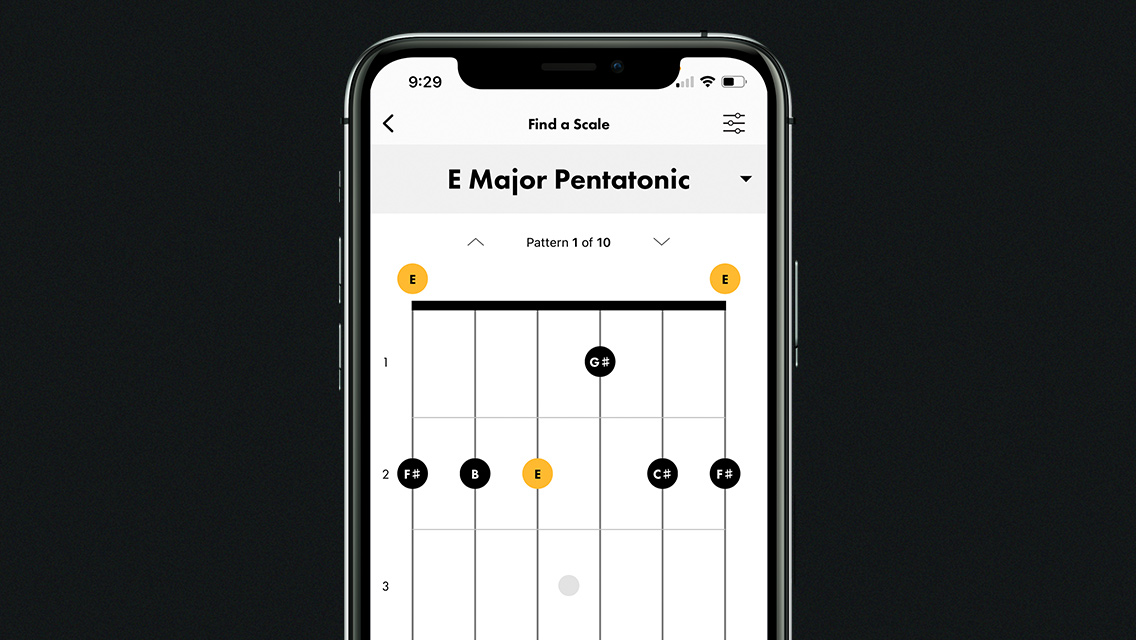By Ben Nemeroff
How to Play the A Major Scale on Guitar
Learn the A Major scale on guitar and get started with exercises to build your skills. Practice the scale positions with diagrams and tabs.

Sections
Lesson: Playing the A Major Scale on Guitar
Playing the A major scale is great exercise, whether you’re new to guitar or you’ve been playing for years. The A major scale turns up in many genres of music, so knowing these notes will often come in handy on your musical journey.
Additionally, learning your major scales is an excellent way to train your ear and get more familiar with your instrument, even if you don’t know much about music theory yet.
In this lesson, we’ll look at what notes make up the A major scale and learn how to play this scale in two positions. Finally, we’ll go over some scale exercises you can do to add this important scale to your guitar practice routine. Ready to get started?
Notes in the A Major Scale
There are seven notes in the A major scale:
A
B
C#
D
E
F#
G#
The first note, A, is the root note of the scale. If you were building an A major chord, you would combine the root note A with the major third C# and the perfect fifth E.
You can play the A major scale in many different places on the fretboard of your guitar. No matter where you start, the A major scale will always contain these same seven notes.
Now, let’s take a look at the different positions and finger placements you’ll need to learn in order to play the A major scale on the guitar.
Don’t miss out!
Be the first to know about new products, featured content, exclusive offers and giveaways.
A Major Scale Positions
Guitar scale diagrams can be a helpful tool when you’re learning to play the A major scale. These diagrams represent the fretboard of your guitar. In the diagrams below, each dot shows you which note you’ll play on a specific fret and string. If you see a dot with a note above the string, play the string in an open position. The yellow dots indicate the root note of the scale. In this case, that root note is A.
A Major Scale - Open Position
To properly play the A major scale in open position, use your index finger to play notes on the first fret, your middle finger for notes on the second, your ring finger for notes on the third, and your pinky for notes on the fourth.

A Major Scale - 4th Position
Next, you’ll move your hand up so that your index finger is on the fourth fret to play the A major scale in 4th position. This scale starts with your middle finger on the fifth fret of the E string. Use your ring finger for notes on the sixth fret and your pinky finger for notes on the seventh fret.

A Major Scale Tabs
Next, we’re going to take a second look at the A major scale in open and fourth position. However, this time we’ll rely on a different method of notation. Unlike guitar scale diagrams, which lay out all the notes in a scale at once, guitar tabs show you which notes to play in what order.
You might find that you prefer using tabs over diagrams, or vice versa, and that’s totally fine. Whichever form of notation you prefer, it’s still important to understand both. They are both used rather commonly, so learning to play with both is a good practice that will help ensure you’re not limited as you continue studying guitar.
With that said, let’s take a look at guitar tabs for both of the scales we just studied.
Open Position
To play the A major scale in the open position, start by playing an open note on your A string, then place your middle finger on the second fret of that string. Keep following the tab to complete playing the scale.

4th Position
To play the A major scale in fourth position, start with your middle finger on the fifth fret of your low E string. Use your index finger for notes on the fourth fret, your ring finger for notes on the sixth fret, and your pinky finger for notes on the seventh fret. Follow the tab to play this scale in fourth position.

A Major Scale Exercises
If you want to memorize and master the A major scale, the best way to do it is to play the scale over and over. Don’t rush! Instead, make sure that each note is fretted cleanly and that you’re using the proper finger placement. As your fingers get stronger and the pattern of the scale becomes more familiar, you can start to play a little faster. Try using a metronome as you practice playing scales to help you keep time while you play.
You might also like to play the two A major scale positions you’ve learned, switching back and forth between them. As you play, listen to the differences in pitch as you play the same notes on different spots on the fretboard.
Additionally, once you’ve mastered the scales with your fretting hand, your scales are a great time to practice technique with your picking hand. Try using your scale practice to work on your alternate picking technique. If alternate picking isn’t challenging enough, try playing your scales with a syncopated rhythm. Practice your scales regularly, and you’re sure to see improvements in your finger strength and dexterity, and you’ll be training your ears too. Keep playing and keep practicing your scales with a free trial of Fender Play.

